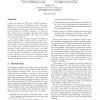Free Online Productivity Tools
i2Speak
i2Symbol
i2OCR
iTex2Img
iWeb2Print
iWeb2Shot
i2Type
iPdf2Split
iPdf2Merge
i2Bopomofo
i2Arabic
i2Style
i2Image
i2PDF
iLatex2Rtf
Sci2ools
TON
2016
2016
Understanding RFID Counting Protocols
Counting the number of RFID tags, or RFID counting, is needed by a wide array of important wireless applications. Motivated by its paramount practical importance, researchers have developed an impressive arsenal of techniques to improve the performance of RFID counting (i.e., to reduce the time needed to do the counting). This paper aims to gain deeper and fundamental insights in this subject to facilitate future research on this topic. As our central thesis, we find out that the overlooked key design aspect for RFID counting protocols to achieve nearoptimal performance is a conceptual separation of a protocol into two phases. The first phase uses small overhead to obtain a rough estimate, and the second phase uses the rough estimate to further achieve an accuracy target. Our thesis also indicates that other performance-enhancing techniques or ideas proposed in the literature are only of secondary importance. Guided by our central thesis, we manage to design near-optimal protocols t...
TON 2016 |
Related Content
| Added | 11 Apr 2016 |
| Updated | 11 Apr 2016 |
| Type | Journal |
| Year | 2016 |
| Where | TON |
| Authors | Ziling Zhou, Binbin Chen, Haifeng Yu |
Comments (0)

